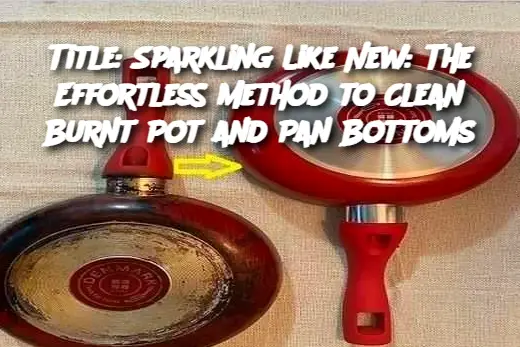-
Sprinkle Baking Soda:
-
Flip your pot or pan upside down. Generously sprinkle baking soda over the dirty bottom surface.
-
-
Add Dish Soap:
-
Add a few drops of dish soap directly on top of the baking soda. This boosts degreasing power.
-
-
Pour White Vinegar:
-
Carefully pour white vinegar over the baking soda. Let it fizz and bubble—it’s breaking down tough residue. Allow it to sit for 10–15 minutes.
-
-
Scrub Gently:
-
Using a ball of crumpled aluminum foil or a non-scratch scrub pad, begin scrubbing the base in circular motions.
-
For tight spots or grooves, use an old toothbrush.
-
-
Rinse & Dry:
-
Rinse with warm water and dry with a clean cloth. Admire the shine!
-
Serving and Storage Tips (Maintaining Your Cookware):
-
Repeat Monthly: For frequently used pots and pans, deep clean the base once a month to prevent buildup.
-
Avoid Steel Wool on Nonstick: Use only soft scrubbers or foil to protect coating and surface.
-
Dry Immediately: After washing, dry thoroughly to prevent rust or water stains.
-
Use Heat Moderately: Avoid overheating empty pans, which causes discoloration and burns at the base.
Variants (Alternative Natural Cleaning Methods):
-
Lemon and Salt Scrub: Cut a lemon in half, dip it in coarse salt, and scrub the pan base for natural degreasing and shine.
-
Cream of Tartar Paste: Mix with water into a paste and apply for a gentler clean on delicate metals like copper or aluminum.
-
Ketchup Trick (for Tarnish): Spread ketchup on the base of copper or stainless pans, leave for 10 minutes, then rinse and shine.
-
Boiling Water Method: For extreme cases, boil water with vinegar inside the pan, then use the hot pan bottom to loosen buildup on the outside.
FAQ:
Q: Can I use this method on non-stick pans?
A: Yes, but be gentle and avoid scrubbing the non-stick surface itself. Focus on the metal bottom and use soft scrubbers only.
Q: Will vinegar damage my pots?
A: No—white vinegar is safe for stainless steel and most metals, but avoid using it on cast iron or aluminum frequently as it can react with the metal.
Q: What if the stains still won’t come off?
A: Repeat the process, or let the baking soda and vinegar sit longer before scrubbing. For extra stubborn spots, try applying a paste overnight.
Q: Is this method eco-friendly?
A: Yes! All ingredients are non-toxic, biodegradable, and safe for use around food and pets.
Q: How can I prevent the base from getting so dirty again?
A: Wipe down the bottom of pans after each use, avoid high heat cooking when unnecessary, and clean spills promptly.
Conclusion:
No more tossing out your favorite cookware because of ugly, burnt bottoms. With just a few household ingredients and minimal elbow grease, you can restore the shine and prolong the life of your pots and pans. It’s affordable, natural, and incredibly satisfying—give it a try and let your kitchen sparkle again
